Analysis of Energy-Related-CO2-Emission Decoupling from Economic Expansion and CO2 Drivers: The Tianjin Experience in China
Abstract
1. Introduction
2. Literature Review
2.1. Decoupling Theory
2.2. CO2 Driver Analysis
3. Materials and Methods
3.1. Study Area
3.2. Methods
- The IPCC inventory method was used to account for CO2 in Tianjin from 2005 to 2022 in four sources: energy activities, industrial processes, waste disposal, and land-use change and forestry.
- Analysis of CO2 and economic decoupling using the Tapio decoupling model.
- Analysis of the drivers of energy CO2 emissions using the LMDI model.
3.3. CO2 Emission Accounting
3.3.1. Energy Activities
3.3.2. Industrial Processes
3.3.3. Waste Disposal
3.3.4. Land-Use Change and Forestry
3.4. Tapio Decoupling Model
3.5. Decomposition of CO2 Emission Drivers Based on the LMDI Model
3.6. Data Sources
4. Results
4.1. CO2 Accounting Results
4.1.1. CO2 Emission Profile
4.1.2. Sectoral CO2 Emissions
4.2. The Decoupling Relationship between CO2 and the Economy
4.3. Five Drivers of Energy CO2 Emissions
4.3.1. Population-Size Effect
4.3.2. Economic-Output Effect
4.3.3. Industrial Structure
4.3.4. Energy Intensity
4.3.5. Energy Structure
5. Discussion
6. Conclusions and Policy Implications
- (1)
- From 2005 to 2022, CO2 emissions in Tianjin show a trend of increasing, then decreasing, and then increasing again, with a downward trend between 2013 and 2017. This is mainly due to the reduction in emissions from industrial products and the transportation sector. CO2 from energy consumption consistently constituted the majority of Tianjin’s CO2 emissions, exceeding 90% annually, while emissions stemming from industrial production processes made up approximately 10% of the annual emissions.
- (2)
- The decoupling index of CO2 throughout the study period shows three states, weak decoupling, expansive negative decoupling, and strong decoupling, and overall, the weak decoupling state is the most prevalent. From 2019 to 2020, there was an expansive negative decoupling state, signifying that the rate of increase in CO2 emissions in Tianjin surpassed the rate of economic expansion.
- (3)
- The contribution of all five drivers to CO2 emissions is positively contributing each year and shows an increasing trend. Economic output emerges as a predominant force driving CO2 emissions from 2005 to 2022. Therefore, Tianjin needs to harmonize the dynamics of economic growth with CO2 emission trends to foster sustainable development. Among the drivers, the industrial structure exerts the most evident mitigating influence on CO2 emissions. Therefore, refining the overall industrial framework and recalibrating its internal components can be instrumental in attaining CO2 emission reduction objectives while maintaining rapid economic progress.
Author Contributions
Funding
Institutional Review Board Statement
Informed Consent Statement
Data Availability Statement
Conflicts of Interest
References
- Althor, G.; Watson, J.E.M.; Fuller, R.A. Global mismatch between greenhouse gas emissions and the burden of climate change. Sci. Rep. 2016, 6, 20281. [Google Scholar] [CrossRef] [PubMed]
- Wang, Q.; Yang, X. New insight into aggressive Intended Nationally Determined Contributions in China—What lessons China should learn from Germany to reduce production-based carbon emission. J. Clean. Prod. 2021, 279, 123522. [Google Scholar] [CrossRef]
- Al-Amin, A.Q.; Rasiah, R.; Chenayah, S. Prioritizing climate change mitigation: An assessment using Malaysia to reduce carbon emissions in future. Environ. Sci. Policy 2015, 50, 24–33. [Google Scholar] [CrossRef]
- Zhu, B.; Ye, S.; Jiang, M.; Wang, P.; Wu, Z.; Xie, R.; Chevallier, J.; Wei, Y.-M. Achieving the carbon intensity target of China: A least squares support vector machine with mixture kernel function approach. Appl. Energy 2019, 233–234, 196–207. [Google Scholar] [CrossRef]
- Gao, C.; Ge, H.; Lu, Y.; Wang, W.; Zhang, Y. Decoupling of provincial energy-related CO2 emissions from economic growth in China and its convergence from 1995 to 2017. J. Clean. Prod. 2021, 297, 126627. [Google Scholar] [CrossRef]
- Raza, M.Y.; Lin, B. Analysis of Pakistan’s electricity generation and CO2 emissions: Based on decomposition and decoupling approach. J. Clean. Prod. 2022, 359, 132074. [Google Scholar] [CrossRef]
- Chen, W.; Yan, S. The decoupling relationship between CO2 emissions and economic growth in the Chinese mining industry under the context of carbon neutrality. J. Clean. Prod. 2022, 379, 134692. [Google Scholar] [CrossRef]
- Wang, Q.; Han, X. Is decoupling embodied carbon emissions from economic output in Sino-US trade possible? Technol. Forecast. Soc. Chang. 2021, 169, 120805. [Google Scholar] [CrossRef]
- Ozturk, I.; Majeed, M.T.; Khan, S. Decoupling and decomposition analysis of environmental impact from economic growth: A comparative analysis of Pakistan, India, and China. Environ. Ecol. Stat. 2021, 28, 793–820. [Google Scholar] [CrossRef]
- Wang, J.; Li, Z.; Wu, T.; Wu, S.; Yin, T. The decoupling analysis of CO2 emissions from power generation in Chinese provincial power sector. Energy 2022, 255, 124488. [Google Scholar] [CrossRef]
- Wang, M.; Feng, C. Towards a decoupling between economic expansion and carbon dioxide emissions in resources sector: A case study of China’s 29 non-ferrous metal industries. Resour. Policy 2021, 74, 102249. [Google Scholar] [CrossRef]
- Shan, Y.; Fang, S.; Cai, B.; Zhou, Y.; Li, D.; Feng, K.; Hubacek, K. Chinese cities exhibit varying degrees of decoupling of economic growth and CO2 emissions between 2005 and 2015. One Earth 2021, 4, 124–134. [Google Scholar] [CrossRef]
- Guan, D.; Meng, J.; Reiner, D.M.; Zhang, N.; Shan, Y.; Mi, Z.; Shao, S.; Liu, Z.; Zhang, Q.; Davis, S.J. Structural decline in China’s CO2 emissions through transitions in industry and energy systems. Nat. Geosci. 2018, 11, 551–555. [Google Scholar] [CrossRef]
- OECD. Indicators to Measure Decoupling of Environmental Pressure from Economic Growth; OECD: Paris, France, 2002. [Google Scholar]
- Vehmas, J.; Kaivo-Oja, J.; Luukkanen, J. Global Trends of Linking Environmental Stress and Economic Growth; Turku School of Economics and Busies Administration: Turku, Finland, 2003; Volume 18, pp. 55–60. [Google Scholar]
- Charlier, D.; Fizaine, F. Decoupling gross domestic product and consumption of raw materials: A macro-panel analysis. Sustain. Prod. Consum. 2023, 36, 194–206. [Google Scholar] [CrossRef]
- Heming, W.; Qiang, Y.; Zhongwu, L. Decoupling Analysis of China’s Resource Consumption and Economic Growth over the Period 1998–2008. Resour. Sci. 2011, 33, 1757–1767. (In Chinese) [Google Scholar]
- Liu, H.; Zhang, Z. Probing the carbon emissions in 30 regions of China based on symbolic regression and Tapio decoupling. Environ. Sci. Pollut. Res. 2022, 29, 2650–2663. [Google Scholar] [CrossRef]
- Wang, Q.; Jiang, X.; Li, R. Comparative Decoupling Analysis of Energy-Related Carbon Emission from Electric Output of Electricity Sector in Shandong Province, China. Energy 2017, 127, 78–88. [Google Scholar] [CrossRef]
- Zheng, J.; Wu, S.; Li, S.; Li, L.; Li, Q. Impact of global value chain embedding on decoupling between China’s CO2 emissions and economic growth: Based on Tapio decoupling and structural decomposition. Sci. Total Environ. 2024, 918, 170172. [Google Scholar] [CrossRef]
- Zhang, Z.; Sharifi, A. Analysis of decoupling between CO2 emissions and economic growth in China’s provincial capital cities: A Tapio model approach. Urban Clim. 2024, 55, 101885. [Google Scholar] [CrossRef]
- Rajabi Kouyakhi, N. CO2 emissions in the Middle East: Decoupling and decomposition analysis of carbon emissions, and projection of its future trajectory. Sci. Total Environ. 2022, 845, 157182. [Google Scholar] [CrossRef]
- Ozdemir, A.C. Decomposition and decoupling analysis of carbon dioxide emissions in electricity generation by primary fossil fuels in Turkey. Energy 2023, 273, 127264. [Google Scholar] [CrossRef]
- Zhao, L.; Zhao, T.; Yuan, R. Drivers of household decarbonization: Decoupling and decomposition analysis. J. Clean. Prod. 2021, 289, 125154. [Google Scholar] [CrossRef]
- Xiong, C.; Chen, S.; Gao, Q.; Xu, L. Analysis of the influencing factors of energy-related carbon emissions in Kazakhstan at different stages. Environ. Sci. Pollut. Res. 2020, 27, 36630–36638. [Google Scholar] [CrossRef] [PubMed]
- Ren, Y.; Ren, X.; Hu, J. Driving factors of China’s city-level carbon emissions from the perspective of spatial spillover effect. Carbon Manag. 2019, 10, 551–566. [Google Scholar] [CrossRef]
- Lu, C.; Li, W. A comprehensive city-level GHGs inventory accounting quantitative estimation with an empirical case of Baoding. Sci. Total Environ. 2019, 651, 601–613. [Google Scholar] [CrossRef] [PubMed]
- Liu, M.; Zhang, X.; Zhang, M.; Feng, Y.; Liu, Y.; Wen, J.; Liu, L. Influencing factors of carbon emissions in transportation industry based on CD function and LMDI decomposition model: China as an example. Environ. Impact Assess. Rev. 2021, 90, 106623. [Google Scholar] [CrossRef]
- Zuo, Z.; Guo, H.; Cheng, J. An LSTM-STRIPAT model analysis of China’s 2030 CO2 emissions peak. Carbon Manag. 2020, 11, 577–592. [Google Scholar] [CrossRef]
- Wang, H.; Ang, B.W.; Su, B. Assessing drivers of economy-wide energy use and emissions: IDA versus SDA. Energy Policy 2017, 107, 585–599. [Google Scholar] [CrossRef]
- Song, C.; Zhao, T.; Wang, J. Spatial-temporal analysis of China’s regional carbon intensity based on ST-IDA from 2000 to 2015. J. Clean. Prod. 2019, 238, 117874. [Google Scholar] [CrossRef]
- Zhang, C.; Zhao, Y.; Shi, C.; Chiu, Y.-H. Can China achieve its water use peaking in 2030? A scenario analysis based on LMDI and Monte Carlo method. J. Clean. Prod. 2021, 278, 123214. [Google Scholar] [CrossRef]
- Xu, S.; Zhang, L.; Liu, Y.; Zhang, W.; He, Z.; Long, R.; Chen, H. Determination of the factors that influence increments in CO2 emissions in Jiangsu, China using the SDA method. J. Clean. Prod. 2017, 142, 3061–3074. [Google Scholar] [CrossRef]
- Ribeiro, L.C.D.S.; Filho, J.F.D.S.; Santos, G.F.D.; Freitas, L.F.D.S. Structural decomposition analysis of Brazilian greenhouse gas emissions. World Dev. Sustain. 2023, 2, 100067. [Google Scholar] [CrossRef]
- Yu, S.; Zhang, Q.; Hao, J.L.; Ma, W.; Sun, Y.; Wang, X.; Song, Y. Development of an extended STIRPAT model to assess the driving factors of household carbon dioxide emissions in China. J. Environ. Manag. 2023, 325, 116502. [Google Scholar] [CrossRef] [PubMed]
- Ziyuan, C.; Yibo, Y.; Simayi, Z.; Shengtian, Y.; Abulimiti, M.; Yuqing, W. Carbon emissions index decomposition and carbon emissions prediction in Xinjiang from the perspective of population-related factors, based on the combination of STIRPAT model and neural network. Environ. Sci. Pollut. Res. 2022, 29, 31781–31796. [Google Scholar] [CrossRef]
- Alajmi, R.G. Factors that impact greenhouse gas emissions in Saudi Arabia: Decomposition analysis using LMDI. Energy Policy 2021, 156, 112454. [Google Scholar] [CrossRef]
- Ang, B.W. LMDI decomposition approach: A guide for implementation. Energy Policy 2015, 86, 233–238. [Google Scholar] [CrossRef]
- Liao, C.; Wang, S.; Fang, J.; Zheng, H.; Liu, J.; Zhang, Y. Driving forces of provincial-level CO2 emissions in China’s power sector based on LMDI method. Energy Procedia 2019, 158, 3859–3864. [Google Scholar] [CrossRef]
- Yang, P.; Liang, X.; Drohan, P.J. Using Kaya and LMDI models to analyze carbon emissions from the energy consumption in China. Environ. Sci. Pollut. Res. 2020, 27, 26495–26501. [Google Scholar] [CrossRef]
- Wen, L.; Li, Z. Provincial-level industrial CO2 emission drivers and emission reduction strategies in China: Combining two-layer LMDI method with spectral clustering. Sci. Total Environ. 2020, 700, 134374. [Google Scholar] [CrossRef]
- Quan, C.; Cheng, X.; Yu, S.; Ye, X. Analysis on the influencing factors of carbon emission in China’s logistics industry based on LMDI method. Sci. Total Environ. 2020, 734, 138473. [Google Scholar] [CrossRef]
- Chontanawat, J.; Wiboonchutikula, P.; Buddhivanich, A. An LMDI decomposition analysis of carbon emissions in the Thai manufacturing sector. Energy Rep. 2020, 6, 705–710. [Google Scholar] [CrossRef]
- Wang, C.; Wu, K.; Zhang, X.; Wang, F.; Zhang, H.; Ye, Y.; Wu, Q.; Huang, G.; Wang, Y.; Wen, B. Features and drivers for energy-related carbon emissions in mega city: The case of Guangzhou, China based on an extended LMDI model. PLoS ONE 2019, 14, e0210430. [Google Scholar] [CrossRef] [PubMed]
- Yang, F.; Shi, L.; Gao, L. Probing CO2 emission in Chengdu based on STRIPAT model and Tapio decoupling. Sustain. Cities Soc. 2023, 89, 104309. [Google Scholar] [CrossRef]
- Yang, J.; Huang, X. The 30 m annual land cover dataset and its dynamics in China from 1990 to 2019. Earth Syst. Sci. Data 2021, 13, 3907–3925. [Google Scholar] [CrossRef]
- Tapio, P. Towards a theory of decoupling: Degrees of decoupling in the EU and the case of road traffic in Finland between 1970 and 2001. Transp. Policy 2005, 12, 137–151. [Google Scholar] [CrossRef]
- Kaya, Y. Impact of Carbon Dioxide Emission Control on GNP Growth: Interpretation of Proposed Scenarios; IPCC Energy and Industry Subgroup, Response Strategies Working Group: Geneva, Switzerland, 1990. [Google Scholar]
- Kaya, Y.; Yokobori, K. Environment, Energy, and Economy: Strategies for Sustainability; United Nations University Press: Tokyo, Japan, 1997. [Google Scholar]
- Shichun, X.; Rong, X.; Zhengxia, H. Influential Factors and Policy Implications of Carbon Emissions for Energy Consumption in China. Resour. Sci. 2012, 34, 2–12. (In Chinese) [Google Scholar]
- Du, X.; Shen, L.; Wong, S.W.; Meng, C.; Yang, Z. Night-time light data based decoupling relationship analysis between economic growth and carbon emission in 289 Chinese cities. Sustain. Cities Soc. 2021, 73, 103119. [Google Scholar] [CrossRef]
- Yasmeen, H.; Wang, Y.; Zameer, H.; Solangi, Y.A. Decomposing factors affecting CO2 emissions in Pakistan: Insights from LMDI decomposition approach. Environ. Sci. Pollut. Res. 2020, 27, 3113–3123. [Google Scholar] [CrossRef]
- Komarova, A.V.; Filimonova, I.V.; Kartashevich, A.A. Energy consumption of the countries in the context of economic development and energy transition. Energy Rep. 2022, 8, 683–690. [Google Scholar] [CrossRef]
- International Energy Agency. Global Energy Review CO2 Emissions in 2021; International Energy Agency: Paris, France, 2022. [Google Scholar]
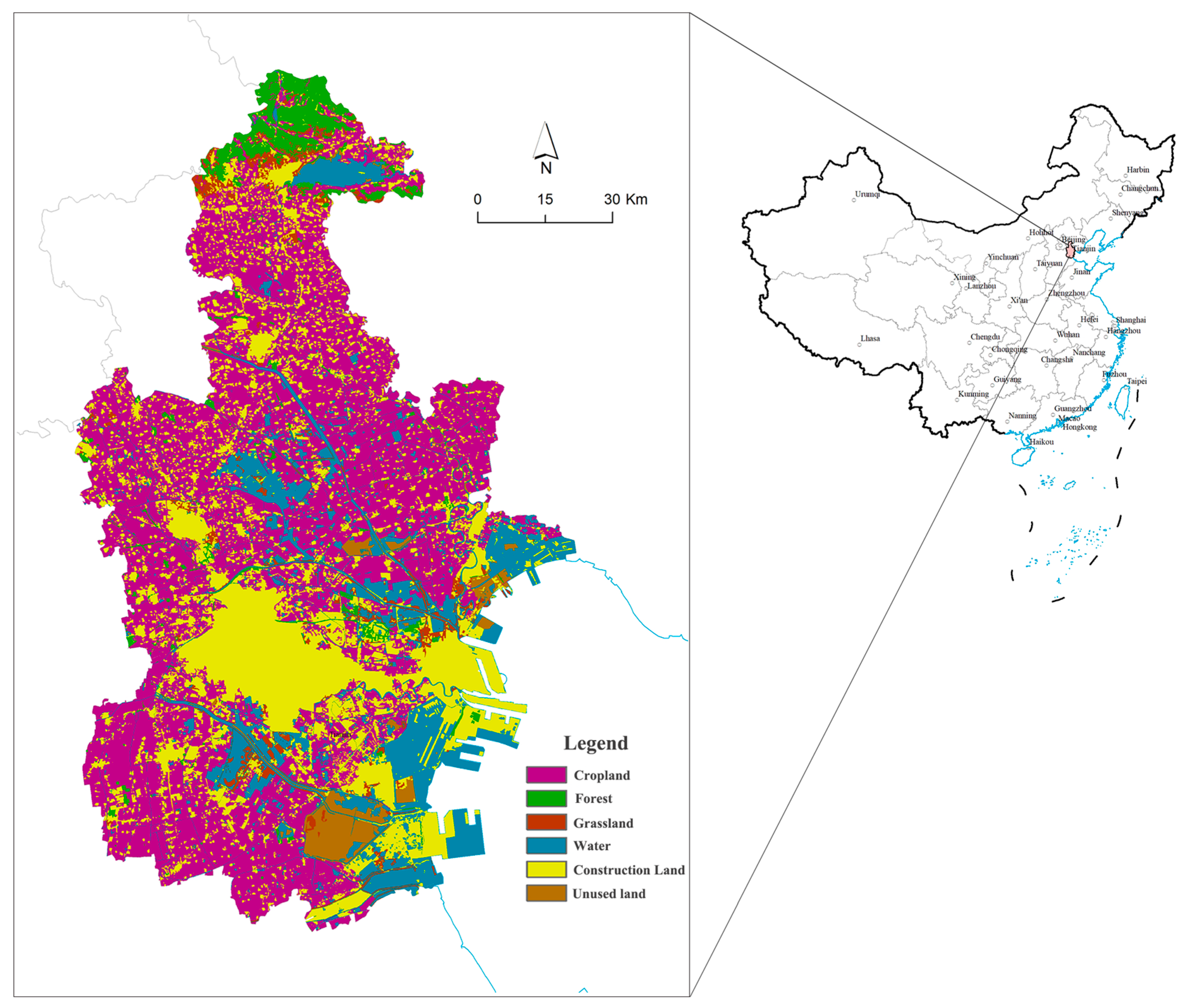
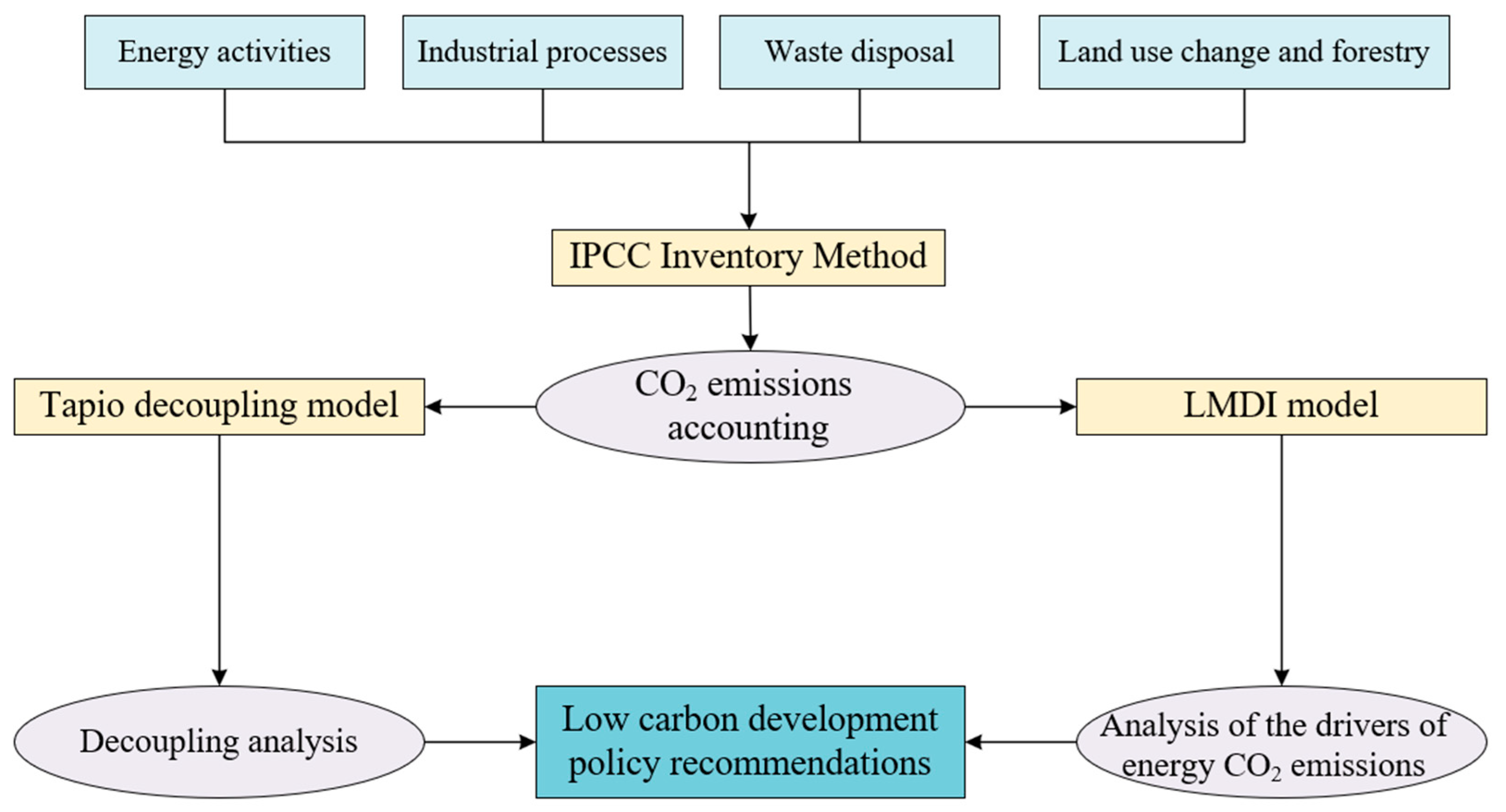



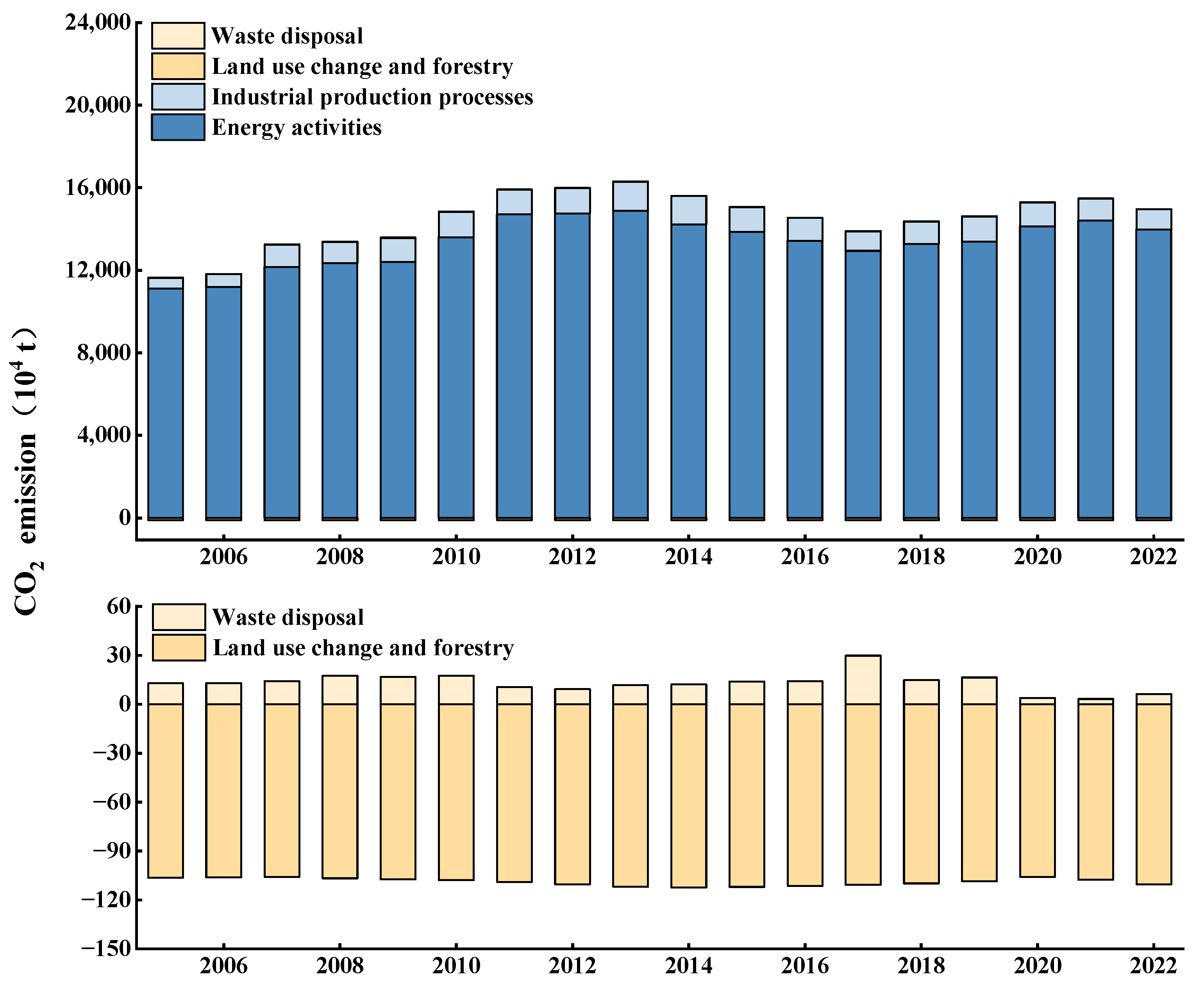



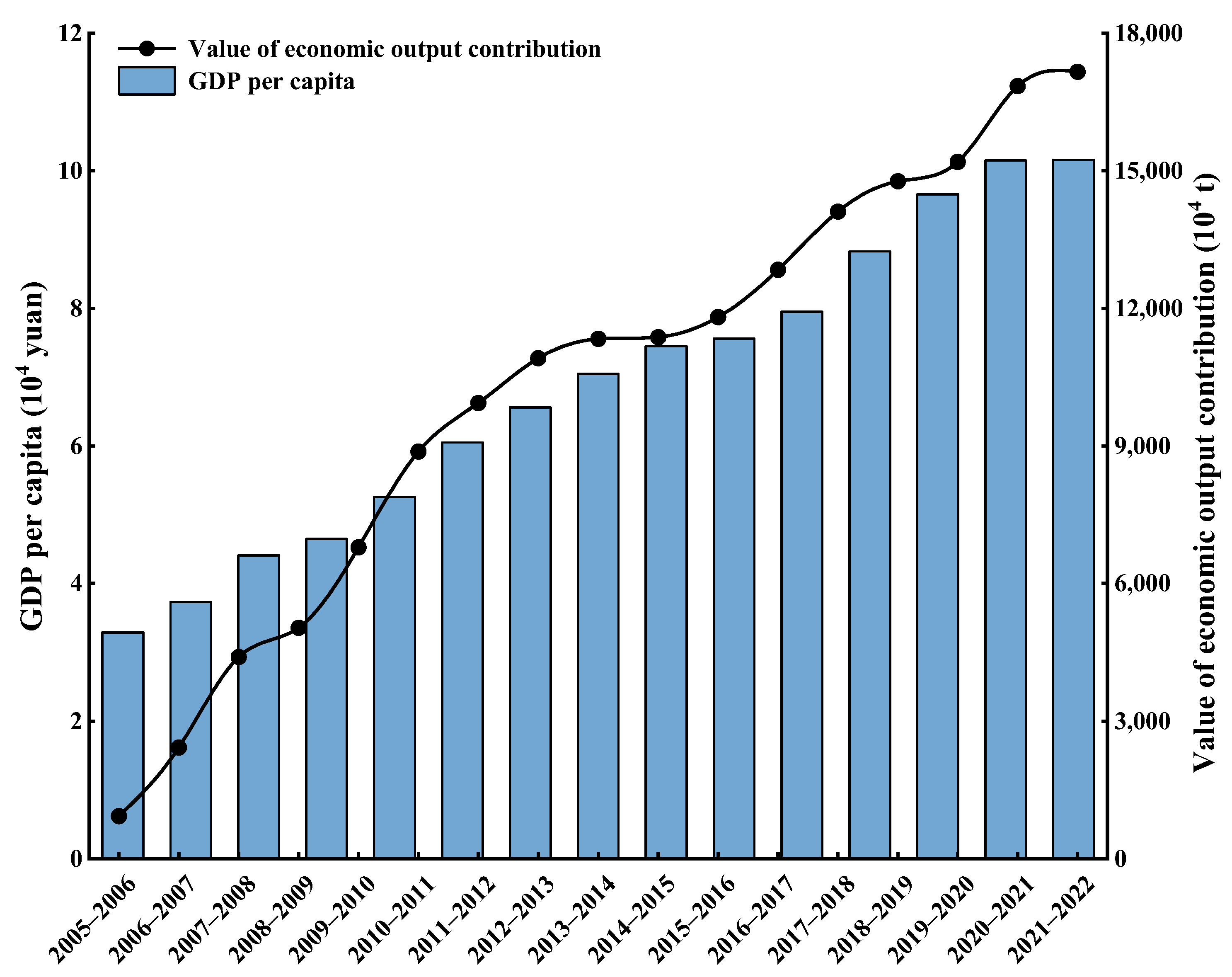


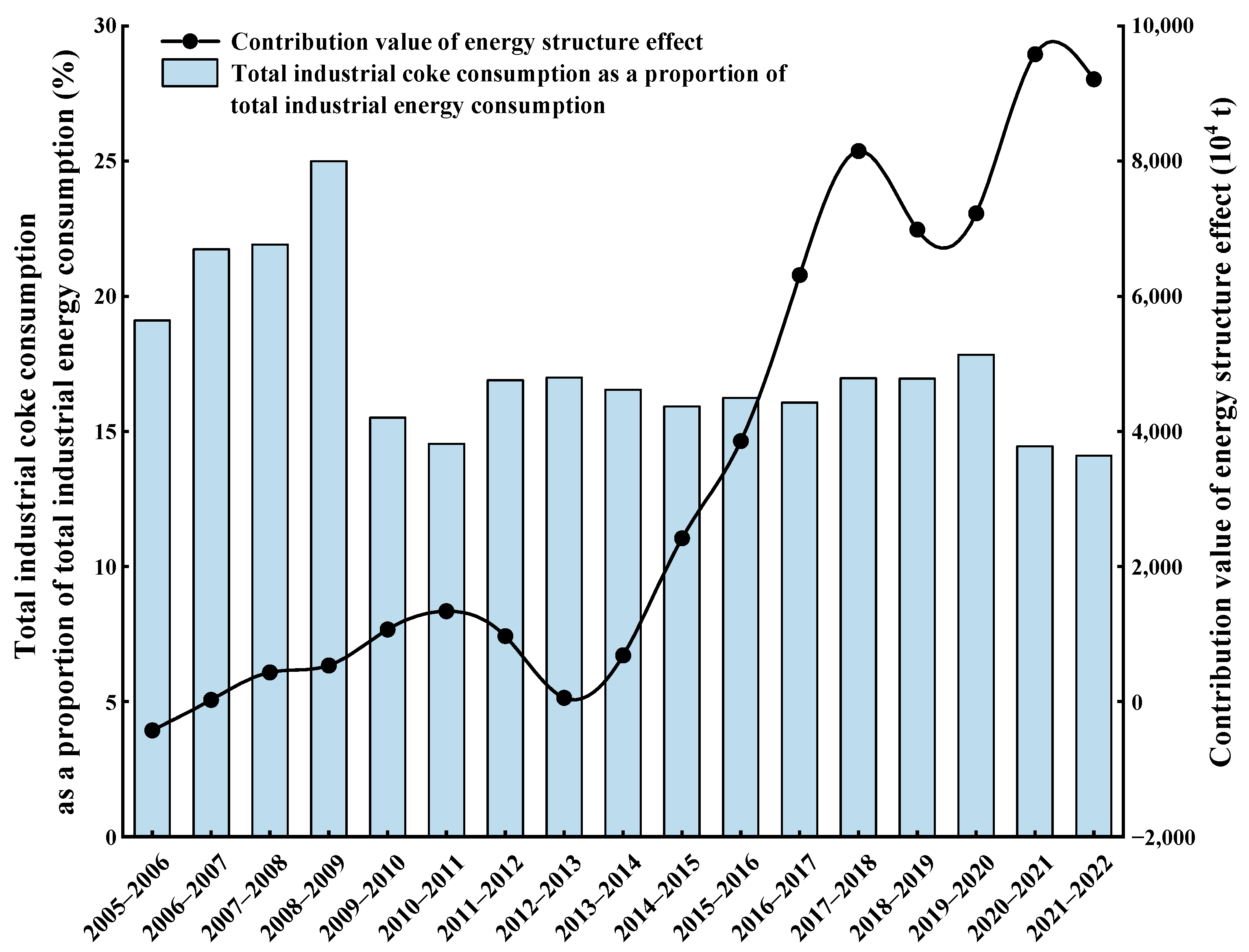
| Method | Time | Benefits | Drawbacks |
|---|---|---|---|
| OECD decoupling factor model [14] | 2001 | Small data requirements and easy to understand | Rough delineation of decoupling patterns |
| Tapio elastic analysis method [10] | 2003 | Up to 8 types of decoupling states | Tends to confuse types |
| Vehmas decoupling model [15] | 2003 | Small data requirements and easy to understand | Degree of decoupling is controversial. Impossible to distinguish between decoupling and coupling |
| Econometric analysis method [16] | - | Diverse forms and complex methods | High data demand |
| Lu Jongwu decoupling model [17] | 2007 | Can visualize the economic and environmental load | Rough delineation of decoupling patterns |
| Model | Features |
|---|---|
| IDA [30,31] | It decomposes a target variable into various combinations of influencing factors; the contribution of these several influencing factors can then be calculated. It is widely used, less demanding, and suitable for time series analysis [32]. |
| SDA [33,34] | The input–output tables in China are typically compiled every five years, representing a lengthy interval that hinders more-intensive research endeavors [32]. |
| STIRPAT [35,36] | It has good scalability, quantifies the drivers′ elasticity coefficients, and is mostly used for forecasting carbon emissions. |
| LMDI [32,37] | Affiliated with IDA, it has the advantage of being residual-free and solving zero-value problems [28]. |
Disclaimer/Publisher’s Note: The statements, opinions and data contained in all publications are solely those of the individual author(s) and contributor(s) and not of MDPI and/or the editor(s). MDPI and/or the editor(s) disclaim responsibility for any injury to people or property resulting from any ideas, methods, instructions or products referred to in the content. |
© 2024 by the authors. Licensee MDPI, Basel, Switzerland. This article is an open access article distributed under the terms and conditions of the Creative Commons Attribution (CC BY) license (https://creativecommons.org/licenses/by/4.0/).
Share and Cite
Yang, F.; Lv, Q. Analysis of Energy-Related-CO2-Emission Decoupling from Economic Expansion and CO2 Drivers: The Tianjin Experience in China. Sustainability 2024, 16, 9881. https://doi.org/10.3390/su16229881
Yang F, Lv Q. Analysis of Energy-Related-CO2-Emission Decoupling from Economic Expansion and CO2 Drivers: The Tianjin Experience in China. Sustainability. 2024; 16(22):9881. https://doi.org/10.3390/su16229881
Chicago/Turabian StyleYang, Fengmei, and Qiuli Lv. 2024. "Analysis of Energy-Related-CO2-Emission Decoupling from Economic Expansion and CO2 Drivers: The Tianjin Experience in China" Sustainability 16, no. 22: 9881. https://doi.org/10.3390/su16229881
APA StyleYang, F., & Lv, Q. (2024). Analysis of Energy-Related-CO2-Emission Decoupling from Economic Expansion and CO2 Drivers: The Tianjin Experience in China. Sustainability, 16(22), 9881. https://doi.org/10.3390/su16229881




